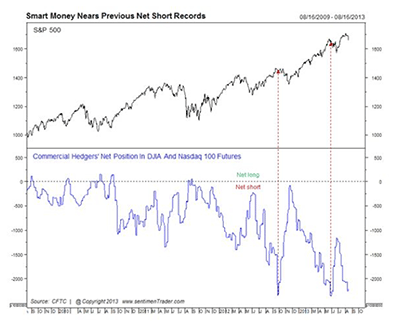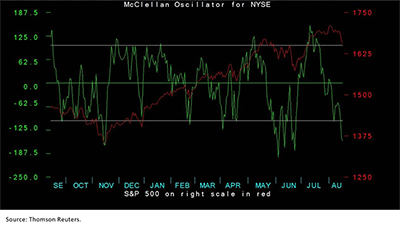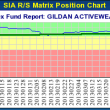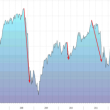“Temptress Time?!”
by Jeffrey Saut, Raymond James
August 19, 2013
“Lefty Rosenthal did not believe in luck. He believed in the odds. In the numbers. In probability. In the math. In the fractions of data he had accumulated copying team statistics onto index cards. He believed that games were fixed and that referees and zebras could be bought. He knew some basketball players who practiced the art of missing basketball rim shots for hours every day, and he knew players who bet the middles between the odd’s spread and got a return of 10 percent on their money. He believed that some athletes played lazy and some of them played hurt. He believed in winning and losing streaks; he believed in point spreads and no-limit bets and card mechanics so good they could deal out cards without breaking the cellophane on the deck. In other words, where gambling was concerned, Lefty believed in everything but luck. Luck was the potential enemy. Luck was the temptress, the seductive whisperer taking you away from the data. Lefty learned early that if he was ever to master the skill and become a professional player, he had to take the even remotest possibility of chance out of the process.”
... Nicholas Pileggi, Casino: Love and Honor in Las Vegas (1995)
I don’t equate gambling with investing, but many do by using margin, options, exotic derivatives, and what-have-you to leverage their various market positions. To be sure, some seers say that the public has been buying 2 to 1, and even 3 to 1, leveraged exchange-traded funds (ETFs) on 50% margin, which gives those positions 4:1 and 6:1 leverage, in an attempt to try and outperform the S&P 500. When leverage works in your favor, it can multiply profits enormously. But, when leverage works against you, it can be devastating! Clearly, the folks at Long Term Capital Management experienced the dark side of leverage. I have never been a good enough investor to use margin, adhering to the mantra, “Investors who use a margin account – shouldn’t, while investors that could use a margin account – don’t.” Like Lefty Rosenthal, I am a believer in the odds; and I am always trying to tip the odds in my favor. When you do so, it tends to take “chance” (luck) out of the investment equation. Of course with that approach at times I look foolish. At times I underperform the indices. At times I sit on too much cash like I did in late 1999 and early 2000. But to be a successful investor, over the long-term, one has to play the odds and have a disciplined approach to investing. As the brilliant investor Seth Klarman, captain of Baupost Partners, writes:
“Risk control to us is a careful aligning of interests, a proper balance in our investing between greed and fear, experienced and collaborative senior management and investment teams that have worked together for quite some time, a consistent and disciplined investment approach where every opportunity is individually and meticulously evaluated on its fundamentals, a strict sell discipline, a willingness to hold cash when opportunity is scarce, a complete avoidance of recourse leverage, and a healthy level of fear.”
To this point, I had dinner the other night with the disciplined investment team at Day Hagan Asset Management. At the table were Don Hagan, Art Day, and my long-time friend Art Huprich. Don Hagan built many of the investment models used by the Ned Davis organization and is likely one of the few people that ever left Ned Davis to start his own firm. For those unfamiliar with Ned Davis, Ned left the brokerage firm of J.C. Bradford in the 1970s to found Ned Davis Research, arguably the best quantitative stock market research resource on the plant. Obviously with that kind of background Don’s models work. Art Day was a very successful financial advisor and Art Huprich, well anyone at Raymond James knows Art was our chief technical analyst. What I really like about Day Hagan is that they have a “sell discipline” consistent with Benjamin Graham’s mantra, “The essence of portfolio management is the management of risks, not the management of returns.” This discipline is reflected in Day Hagan’s mutual fund (DHAAX/$11.13). While some merely look at the performance numbers, it should be noted that DHAAX’s track record, versus the S&P 500 (total return) for the three-year period ending July 31, 2013, has been achieved with a Beta of just 0.68, which is well below the stock market’s Beta of 1.0 (read: volatility). Obviously this is a risk adverse mutual fund, which I own. For the kind of market I envision going forward, this is one of the funds you should consider.
Turning to the equity markets, given last week’s action it leaves little doubt that my hunch the upside breakout above 1700 was a false breakout. Indeed, the S&P 500 (SPX/1655.83) confirmed the Dow’s downside by traveling below its 50-day moving average and in the process has set a low lower than the previous week’s low (1684 vs. Friday’s low of 1652). Moreover, during the past few months “they” have been running the small caps as represented by the Russell 2000 (RUT/1024.30), which is typically what happens into a trading top. Further, the RUT’s Monthly Relative Strength Index (RSI) reached a reading of 75, last seen in June of 2007, and we all know how that turned out. So, my key “pivot point” of 1684 was breached last week, bringing into view minor support at 1650 and then 1620. My belief, however, is that before this pullback is over the SPX has an appointment with somewhere between the June 24th low of ~1560, and the ~1530 level that is around the April 2013 pullback low. As well, 1530 would represent a bit more than my envisioned 10% correction. Worth mentioning is the stock market’s upside momentum did indeed end on July 19th and that the seasonality telegraphed the recent weakness. Certainly the commercial hedgers (read: smart money) heeded the warning signals since they have positioned themselves into some of the highest net-short positions ever. In recent history, this is exactly what happened before the 8.6% correction of 9/12 into 11/12 and the 7.5% pullback of 5/13 to 6/13 (see chart on page 3).
As I am writing, I am watching a video clip of the President saying the Keystone pipeline, “Will only create 60 jobs.” That brings to mind a recent airplane ride where I met the CEO of a short-line railroad located in the Dakotas. He told me his insurance broker had just told him that because of the railroad disaster in the little Quebec town of Lac-Megantic, which killed 47 people, his insurance coverage is going to have to be increased by a factor of four with an attendant price increase; and, his railroad doesn’t even transport crude oil! Ladies and gentlemen, there are roughly 550 short-line railroads in this country. One hundred and ten of them are owned by Genesee & Wyoming (GWR/$87.33/Strong Buy). According to our fundamental analyst (Tyler Brown), most of these short-lines are mom and pop operated and are barely profitable. Such an increase in insurance cost will likely cause a massive consolidation for the industry with GWR probably being the beneficiary. This is a name you should put on your potential “buy list.” For more information, please see our fundamental analyst’s research reports.
The call for this week: Over the weekend a portfolio manager told me that 10% corrections in a bull market are few and far between. Historically, that’s correct, but in recent years history has not mattered much. Consider this, in 2010, 2011, and 2012 I recommended raising cash in the spring with the strategy of putting that cash back to work during the summer. Following those “cash calls” the SPX declined, on an intraday high to intraday low basis, by 16.9% (2010), 21.4% (2011), and 10.9% (2012). This year I opined that “sell in May and go away” was not going to play. However, I do think it plays here. Indeed, we are still in that “dead zone” where there is a void of catalysts – no Fed, no earnings, summer holidays, etc. – which should leave the SPX vulnerable. That said, the McClellan Oscillator is pretty oversold in the short-term, and there are some positive energy points coming in on Tuesday, so some kind of rally attempt should be in the cards. Still, I think rallies are for selling on a trading basis, but remain quite bullish on the longer-term given the 7.4% earnings yield on next year’s estimated earnings.


















